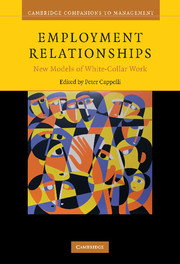Book contents
- Frontmatter
- Contents
- List of figures
- List of tables
- List of contributors
- Foreword
- 1 Introduction
- 2 Corporate restructuring and the employment relationship
- 3 The up and out in organizations
- 4 In the pursuit of quality and quantity: the competing demands in call centers
- 5 Three's a crowd? Understanding triadic employment relationships
- 6 The changed world of large law firms and their lawyers: an opportune context for organizational researchers
- 7 The upside of bureaucracy: unintended benefits for professional careers
- Index
- References
4 - In the pursuit of quality and quantity: the competing demands in call centers
Published online by Cambridge University Press: 02 December 2009
- Frontmatter
- Contents
- List of figures
- List of tables
- List of contributors
- Foreword
- 1 Introduction
- 2 Corporate restructuring and the employment relationship
- 3 The up and out in organizations
- 4 In the pursuit of quality and quantity: the competing demands in call centers
- 5 Three's a crowd? Understanding triadic employment relationships
- 6 The changed world of large law firms and their lawyers: an opportune context for organizational researchers
- 7 The upside of bureaucracy: unintended benefits for professional careers
- Index
- References
Summary
Introduction
To some, call centers represent the modern-day “factory floor.” With strict controls over the quality and quantity of work, Taylorism seems to be alive and well in the call center. The reality is not that simple, however. Call centers, with virtually constant customer contact and attendant interpersonal demands on workers, will always be stressful for workers to a point. How the organization balances the demands of quantity and quality, by controlling the pace and the content (through the scripting and monitoring) of calls, can have a profound effect on the workplace. It can even influence how stressful the interpersonal demands of the job are for workers. Indeed, the choices employers make about how to manage call centers can be more important than the call center context per se in determining employee outcomes.
This chapter starts by providing a basic overview of the call center, highlighting the different types of calls and callers, and the power of technology to control both the quantity and the quality of the service interactions. Much of the chapter is dedicated to a study of how workers struggle to meet the competing demands of quantity and quality. Then I examine all the parties in the interpersonal context for call center workers and highlight the role that supervisors and co-workers may play in mitigating or exacerbating the stresses of the work with customers.
- Type
- Chapter
- Information
- Employment RelationshipsNew Models of White-Collar Work, pp. 112 - 141Publisher: Cambridge University PressPrint publication year: 2008
References
- 1
- Cited by



